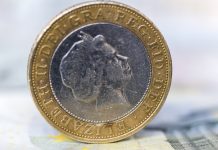The pound was among the worst performing currencies at the beginning of the week. Sterling fell back below US$1.40, undermined by soft UK data.
| What do these figures mean? |
|---|
|
When measuring the value of a pair of currencies, one set equals 1 unit and the other shows the current equivalent. As the market moves, the amount will vary from minute to minute. For example, it could be written: 1 GBP = 1.28934 USD Here, £1 is equivalent to approximately $1.29. This specifically measures the pound’s worth against the dollar. If the US dollar amount increases in this pairing, it’s positive for the pound. Or, if you were looking at it the other way around: 1 USD = 0.77786 GBP In this example, $1 is equivalent to approximately £0.78. This measures the US dollar’s worth versus the British pound. If the sterling number gets larger, it’s good news for the dollar. |
The pound tumbled throughout Monday, as investors reacted to weaker than forecast service sector pmi. The forward-looking service sector indicator dropped to 53 in January, from 54.2 in December. A figure above 50 indicates expansion in the sector, whilst below 50 indicates contraction. This is the weakest reading for the service sector data since September 2016, as consumers continue to reign in their spending. Household budgets have been under increasing pressure thanks to higher prices and lower wages in real terms.
The surprisingly low reading is the third in a hattrick of weak pmi readings. The construction sector and the manufacturing sector disappointed market participants at the end of last week.
| Why does poor economic data drag on a country’s currency? |
|---|
| Slowing economic indicators point to a slowing economy. Weak economies have weaker currencies because institutions look to reduce investments in countries where growth prospects are low and then transfer money to countries with higher growth prospects. These institutions sell out of their investment and the local currency, thus increasing supply of the currency and pushing down the money’s worth. So, when a country or region has poor economic news, the value of the currency tends to fall. |
Last week the pound had rallied, as comments from Bank of England Governor Mark Carney lead market participants to believe that the central bank could adopt a more hawkish approach to monetary policy. However, the soft numbers coming out of the UK recently are causing investors to doubt whether the UK economy is able to sustain higher interest rate levels, which is weighing on sentiment for the pound.
With a light UK economic calendar today, investors will continue to focus on Thursday’s Bank of England rate decision and quarterly inflation report. Brexit headlines could also create volatility in the pair.
US Economy Shows Robust Growth
Confidence in the dollar has improved greatly since the strong US jobs numbers on Friday last week. It received a fresh boost in the previous session after figures showed that the US non-manufacturing pmi hit a 12 ½ year high. The economy is being buoyed by robust growth in new orders, which are fresh signs of a strong start to the year for US economy. The economy is showing impressive signs of growth, even before the effects Trump’s $1.5 trillion tax cut package which only came into effect last month. This is causing investors to fear the US economy overheating, in which case the Fed would need to hike interest rates at a much faster rate than they had originally mapped out for the year.
| Why do raised interest rates boost a currency’s value? |
|---|
| Interest rates are key to understanding exchange rate movements. Those who have large sums of money to invest want the highest return on their investments. Higher interest rate environments tend to offer higher yields. So, if the interest rate or at least the interest rate expectation of a country is relatively higher compared to another, then it attracts more foreign capital investment. Large corporations and investors need local currency to invest. More local currency used then boosts the demand of that currency, pushing the value higher. |
|
This article was initially published on TransferWise.com from the same author. The content at Currency Live is the sole opinion of the authors and in no way reflects the views of TransferWise Inc. |





